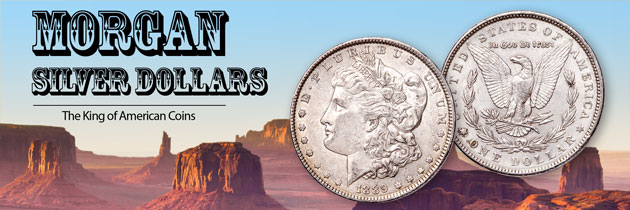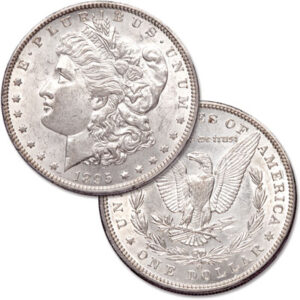Why Not a Queen of American Coins?
The numismatic hobby is accented with colorful nicknames: Horse blanket. V nickel. Wheaties. Greenback. Susie B. Double eagle. Benjamin. The eight bits that make up a dollar or the two bits that used to pay for a haircut back in the day.*
Then there are the two monikers attached to Morgan silver dollars: cart wheel and King of American Coins. The first is a nod to the look-and-feel of a new lustrous, three-quarter-ounce dollar. Tilted in daylight, the shiny silver disc radiates circular beams. The second nickname begs the question: Why not a Queen of U.S. Coins?

If you’re new to coin collecting and Morgan dollars, follow me to discover some interesting milestones on route to dubbing America’s most popular silver dollar.
Royal Rarity
According to the American Numismatic Association, the nickname “King of U.S. Coins” was attached to an early silver dollar dated 1804. But that coin actually was struck from 1834-1845, “when the U.S. Department of State decided to give ‘complete’ type sets of U.S. coins, including the 1804 dollar, as gifts to certain rulers in Asia willing to grant trade concessions to the United States.”
The complicated path to minting this coin is skillfully laid out in The King of American Coins, the United States Silver Dollar of 1804 by Eric P. Newman and fellow numismatist Kenneth E. Bressett.
If the Newman name is new to you, the hobby owes him much, including this coin site at Washington University in his native St. Louis. Read the words of collecting encouragement he wrote Littleton’s own, David Sundman, quoted in our Autumn 2024 Hard to Find catalog, which you can order here. But before you leap to a connection between the book title and the Morgan dollar, let’s pause for a moment in 1885.
Regarded as America’s first career coin dealers, Samuel Hudson and Henry Chapman of Philadelphia put some of their considerable stock up for auction that year. Here’s the excerpt from the catalog that references the 1804 coin:

Bear in mind the auction took place a mere nine years after celebrating the American Centennial of 1876. And that anniversary occurred less than 90 years after the writing of the U.S. Constitution. The framers wanted to put so much distance between England’s monarchy and America’s newly elected representatives that they codified the distinction in Article I. Section 9. Clause 8.4 Titles of Nobility. By 1885, had enough time elapsed that “king” could seep back into everyday vocabulary?
Other Royal Nicknames
Turns out, assigning royal titles in American culture is not all that unusual. It’s most often used to signify rarity. It also denotes a form of reverence tied to an extraordinary level of achievement. It can be found in the music business, for example, with a nickname applied to the always elegantly dressed and well-spoken jazz pianist Edward Kennedy Ellington, better known as Duke.
Or in sports, such as baseball’s Sultan of Swat, the sobriquet bestowed by sportswriters on Hall of Famer Babe Ruth for his phenomenal home-run totals. Or, the lumber industry. The title “baron” was attached to Duane L. Bliss, founder of the Carson & Tahoe Lumber & Fluming Company. Bliss’s enterprise was the largest supplier of timber and lumber to the mining industry, including the Comstock Lode’s 135+ underground silver mines.
1895 Uncirculated and Proof strikes
Let’s now consider another milepost. Seven years before the Chapman Brothers’ 1885 auction, the U.S. Mint started issuing a new dollar design commissioned by U.S. Mint Director Henry Linderman. The silver came from those Nevada mines discovered by prospector Henry Comstock.

The dollar’s designer was George T. Morgan. His American ideal for Liberty was kindergarten teacher Anna W. Williams. In 1878, the new coin was rolling off the presses, its shiny fields glinting in the sunlight, like cart wheels, and offering a satisfying “thwack” on gaming tables and saloon bars by Wild West cowboys.
In 1895, the Philadelphia Mint issued Morgans, both for Circulation and as Proofs. The 12,000 business-grade silver dollars, however, were never released. Speculation continues to this day they were melted.
But the Proofs numbered just 880; by comparison, the San Francisco Mint’s Morgan Proofs totaled 400,000. Philadelphia’s Morgan Proofs thus earned the nickname of “The King of the Morgan Dollars,” according to leading numismatist Q. David Bowers, writing in A Guide Book to Morgan Silver Dollars.
So, with more than 650 million silver Morgans minted 1878-1921, is it a hop, skip and a jump to nicknaming all Morgans “The King of American Coins”? Let us know what you think in the comments section below.
And here’s a second question for you to flip a coin over: If there were a Queen of American Coins, which one would you vote for?
*Quick definitions:
- Horse blanket – Large-size notes that measured 3.125” x 7.375” and printed 1861-1929
- V nickel – Roman numeral for five appeared on coin’s reverse issued from 1883-1913.
- Wheaties – Symbol of abundance, the pair of wheat sheaves appeared on Lincoln cent reverses issued 1909–1958.
- Greenback – Applied to paper currency first issued in March of 1862 to help finance the Civil War.
- Susie B. – Short for the first dollar issued that profiled a historical American woman, the suffragist and social reformer Susan Brownell Anthony.
- Double eagle – $20 gold piece created by the Coinage Act of 1849 at twice the value of a $10 gold piece; both feature an eagle on the reverse.
- Benjamin – First Federal Reserve Note in $100 denomination featured portrait of Founding Father Benjamin Franklin; first printed in 1914.
- Bits – Refers to the “pieces of eight”, or reales, that made up the silver Spanish dollar; struck by hand in Mexico and Central and South America mints, and used by American colonists in the 1600s. In multiples of two, it took eight reales to make a dollar.
SOURCES:
My Coin Guides: Morgan Dollars. Accessed August 6, 2024. http://morgandollars.net/morgan-dollar-mintage/
Newman Numismatic Portal. “The Eric P. Newman Story.” Accessed July 16, 2024. https://nnp.wustl.edu/about#:~:text=Newman%20Story-,Eric%20P
“The 1804 Dollar: The King of America Coins.” American Numismatic Association. Accessed August 2, 2024. https://www.money.org/money-museum/virtual-exhibits-1804dollar/
Wiggins, Kelsey.“Valuable nicknames: The monikers we give our money.” August 8, 2017. Smithsonian National Museum of American History. Accessed July 8, 2024 https://www.americanhistory.si.edu/explore/stories/valuable-nicknames-monikers-we-give-our-money



